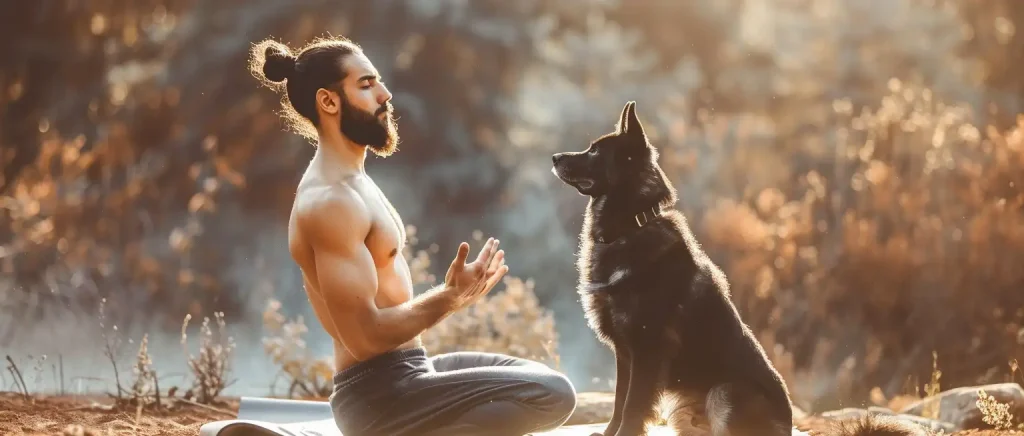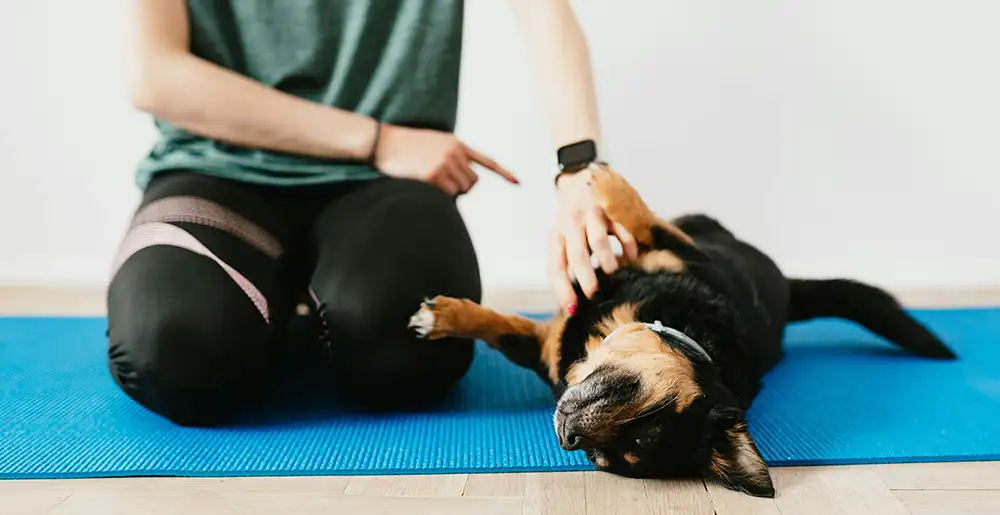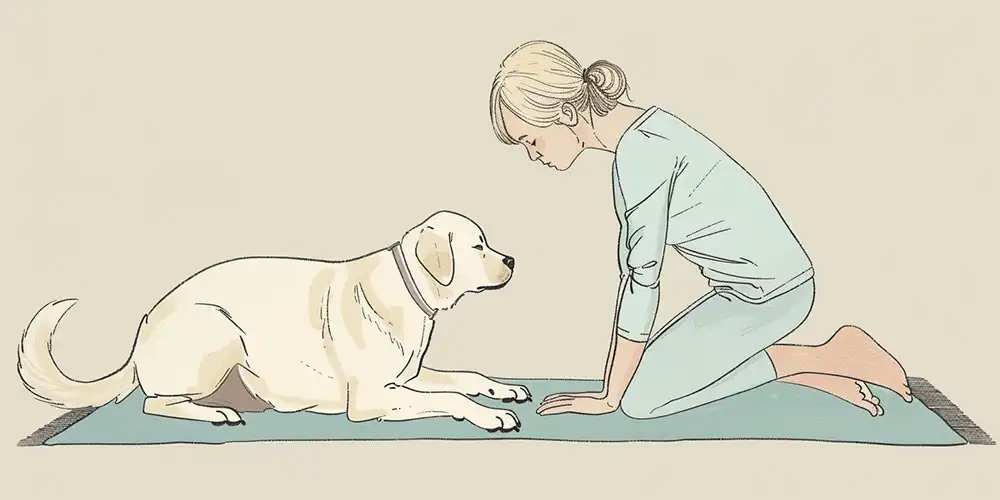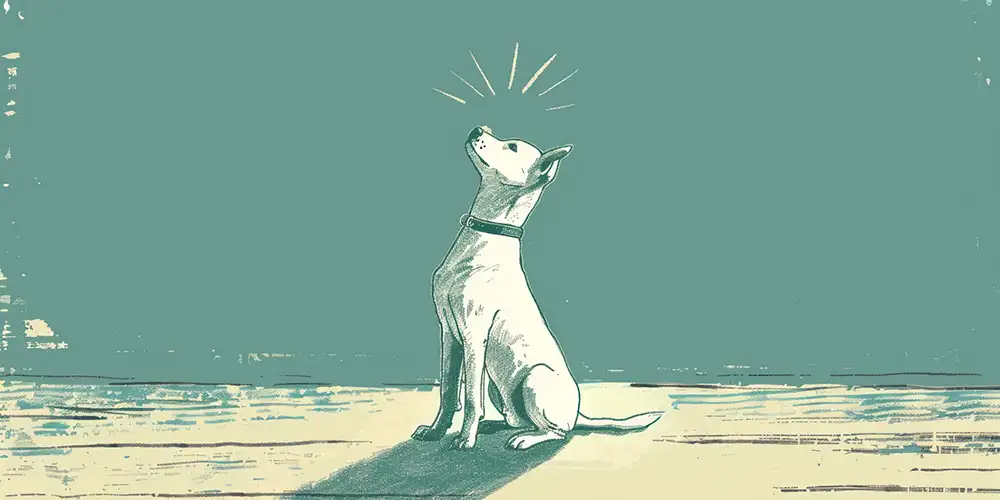Yoga, an ancient practice rooted in India, emphasizes physical postures, breathing exercises, and meditation for a holistic approach to well-being. In recent years, yoga has transcended cultural boundaries and exploded in popularity worldwide. But what if we told you there was a way to incorporate your furry best friend into your yoga practice? Enter Doga, a unique blend of traditional yoga poses adapted for a canine companion. This playful practice fosters a deeper connection between you and your dog while offering a fun and beneficial activity for both of you.
Doga’s origins can be traced back to the early 2000s with yoga instructor Suzi Teitelman. Inspired by the calming effect yoga had on her own dog, she began exploring ways to modify yoga poses to include her canine companion. Teitelman’s innovative approach gained traction, and Doga studios and classes started popping up around the world.

What is Doga?
Doga isn’t about forcing your dog into complex yoga postures. Instead, it’s about creating a shared experience that promotes relaxation, bonding, and a sense of fun. Doga sessions typically involve incorporating your dog’s natural movements and behaviors into a modified yoga routine. This might involve gentle massage techniques while you hold a downward-facing dog pose (adho mukha svanasana) or incorporating playtime with a favorite toy during Warrior II (virabhadrasana II). The key is to focus on creating a calm and positive atmosphere where both you and your dog can unwind and connect.
Can a Dog Really Do Yoga?
While your dog won’t be mastering headstands or pretzel poses, Doga isn’t about achieving a perfect yoga form. Canines naturally engage in movements that resemble some yoga postures. The downward dog position, for example, mirrors a dog’s natural stretching motion. This exercices leverages these natural movements and incorporates them into your practice, creating a unique form of interactive yoga.
What are the Benefits of Doga for Your Dog?
Doga offers a surprising range of benefits for your furry friend. Here’s a closer look at how your pup can benefit from this unique practice:
- Stress Reduction: Just like humans, dogs can experience stress and anxiety. The calming atmosphere of a session, combined with gentle massage and positive reinforcement, can help lower stress hormones and promote relaxation in your dog.
- Improved Physical Health: It incorporates gentle stretches and movements that can increase your dog’s flexibility and range of motion. This can be particularly beneficial for senior dogs or those recovering from injuries.
- Enhanced Mental Stimulation: Doga sessions provide mental stimulation through interaction with you, following cues, and participating in playful activities. This mental engagement can help combat boredom and keep your dog sharp.
- Stronger Bond with You: It creates a unique opportunity for quality time and shared experience between you and your dog. The positive reinforcement and gentle interaction can strengthen your bond and improve obedience.
- Pain Management: For dogs suffering from chronic pain, the gentle stretches and massage techniques incorporated can provide some relief and improve their overall comfort.
Remember, Doga should be a fun and positive experience for your dog. Pay close attention to their body language and stop any activity that seems uncomfortable or causes stress. If you notice any limitations or concerns, consult your veterinarian before continuing.

What are the Benefits of Doga for You?
Doga isn’t just about pampering your pooch; it offers a wealth of benefits for you as well. Here’s how incorporating your dog into your yoga practice can enhance your well-being:
- Stress Reduction and Relaxation: Just like your dog, the calming environment and gentle movements can significantly reduce stress and anxiety for you as well. Focusing on your breath and interacting with your furry friend promotes relaxation, lowers cortisol levels (the stress hormone), and can even improve your sleep quality.
- Increased Physical Activity: Doga sessions often involve playful interaction with your dog, incorporating light movement and stretches. This gentle activity boost can help you stay active, improve your flexibility, and even burn a few extra calories.
- Strengthened Bond with Your Dog: It creates a unique opportunity for quality time and shared experience with your canine companion. The positive reinforcement, gentle touch, and focus required during Doga fosters a deeper connection and strengthens the bond you share with your furry friend.
- Enhanced Mindfulness and Focus: The act of focusing on your breath, your dog’s movements, and the present moment can enhance your mindfulness. This heightened awareness can improve your ability to focus on the task at hand and reduce everyday distractions.
- Greater Appreciation for Your Dog: Spending quality time interacting and connecting with your dog through Doga can lead to a deeper appreciation for their unique personality and unconditional love. This appreciation can strengthen your bond and enrich your life as a pet parent.
- Improved Communication and Training: The focus on positive reinforcement and clear cues can improve communication between you and your dog. This enhanced communication can translate to better overall training and a more well-behaved canine companion.
- Fun and Socialization: It can be a fun and playful activity for both you and your dog. If you participate in group Doga classes, it can also provide a social outlet for you and your pup, allowing you to connect with other dog lovers and their furry friends.
Doga offers a unique way to combine your yoga practice with quality time for your dog. While the benefits listed above are numerous, it’s important to remember that Doga should be a positive and enjoyable experience for both you and your furry friend. Focus on creating a calm and playful atmosphere, and don’t push your dog beyond their comfort level.
Are There Any Disadvantages or Risks for You or Your Dog?
Doga is generally a safe and enjoyable activity for both you and your dog, but there are a few potential drawbacks to consider:
- Not Suitable for All Dogs: Highly energetic or easily excitable dogs might struggle to focus or find it frustrating. Similarly, dogs with injuries or mobility issues may not be suitable candidates. Consult your veterinarian before starting Doga with your dog, especially if they have any underlying health conditions.
- Accidents Can Happen: Even the most well-behaved dog might have an accident during a Doga session. Be prepared for potential potty breaks or excited chewing on your yoga mat. Having cleaning supplies and a designated potty area nearby is a good idea.
- Limited Availability: While Doga’s popularity is growing, finding dedicated Doga classes or studios might still be limited in some areas.

How to Start Doing Yoga with Your Dog
If you’re interested in trying Doga with your dog, here are some steps to get you started:
- Choose the Right Time: Pick a time when you and your dog are calm and relaxed. Avoid times when your dog is hungry, tired, or overly excited.
- Prepare Your Space: Find a quiet, comfortable area with enough space to move around freely. Use a yoga mat or a soft blanket for both you and your dog. Have treats and your dog’s favorite toy on hand for positive reinforcement.
- Start Slow: Keep your first Doga session short and simple. Focus on gentle stretches and basic poses that are comfortable for both you and your dog. Gradually increase the duration and complexity of the practice as your dog gets comfortable.
- Positive Reinforcement: Use praise, treats, and gentle petting to reward your dog for participating and following cues. Keep the atmosphere positive and fun to encourage continued engagement.
- Focus on Bonding: The primary goal of Doga is to connect with your dog and create a shared experience. Don’t get caught up in achieving perfect yoga poses. Focus on enjoying the moment and strengthening your bond with your furry friend.
Remember, Practicing Yoga with your dog is about having fun and fostering a deeper connection with your dog. There are no right or wrong ways to do Doga. Observe your dog’s body language, adjust poses as needed, and most importantly, enjoy the unique opportunity to bond with your canine companion through the practice of yoga
5 Best Doga Poses to Get You Started

Now that you’re prepped and ready to embark on your Doga journey, here are 5 beginner-friendly poses to get you and your pup started:
- Downward-Facing Dog (Adho Mukha Svanasana): This classic yoga pose offers a great foundation for Doga. While you assume the downward-facing dog position with your hips high and heels reaching towards the ground, encourage your dog to sniff your backside or playfully nudge your hand. This pose provides a gentle stretch for your hamstrings and spine while allowing your dog to engage in their natural sniffing behavior.
- Child’s Pose (Balasana): This calming pose is perfect for a moment of relaxation and connection with your dog. Kneel on the floor, sit back on your heels, and rest your forehead on the mat. Your dog might naturally curl up beside you or rest their head on your back, creating a peaceful moment of shared tranquility.
- Mountain Pose (Tadasana): This basic standing pose is a great way to start or end your Doga session. Stand tall with your feet hip-width apart and arms by your side. Encourage your dog to stand in front of you, making eye contact and offering a treat for focus. This pose promotes balance and stability for you while strengthening your dog’s obedience skills through positive reinforcement.
- Warrior II Pose (Virabhadrasana II): This warrior pose offers a gentle hip stretch and strengthens your legs. Step back with one leg, bend your front knee, and raise your arms overhead. For your dog, incorporate a fun element by placing their favorite toy on the ground slightly in front of them. As they reach for the toy, they’ll engage in a natural side stretch that mimics the warrior II pose.
- Corpse Pose (Savasana): End your Doga session with a moment of relaxation in corpse pose. Lie flat on your back with your arms at your sides and palms facing up. Invite your dog to lie beside you or on your lap. Focus on your breath and enjoy the peaceful connection with your furry friend.
Remember, these are just a few examples, and countless variations exist. The key is to find poses that are comfortable for both you and your dog and allow for interaction and bonding. With a little creativity and positive reinforcement, Doga can become a fun and rewarding activity for you and your canine companion.

Conclusion
Doga offers a unique way to deepen your bond with your dog while incorporating yoga’s stress-reducing and health benefits into your routine. Whether you’re a seasoned yogi or a curious beginner, Doga provides a playful and accessible entry point for both you and your furry friend. So, grab your yoga mat, some treats for your pup, and get ready to experience the joy of Doga!
Get more references on Wikipedia about Doga